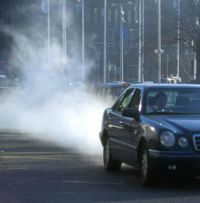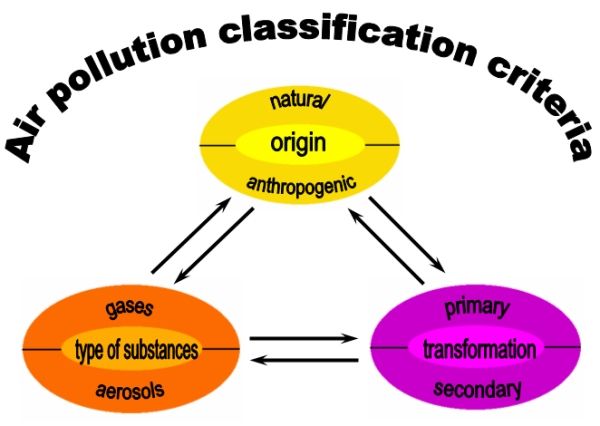|
|
 |
|
|
|
 |
| |
|
|
 |
Climate in cities
Basics |
What is air pollution?
Air pollution consists of gases, solid particulates, and aerosols which change the natural composition of the atmosphere. This material has the potential to be harmful to human health, other living organisms, soil, water, and to damage other parts of environment. |
|
|
|
|
 |
Clean air is composed of chemicals that occur naturally. Oxygen and nitrogen make 99% of dry air, and the remaining 1% consists of argon, carbon dioxide, helium and other trace gases. Additionally, the air contains a variable fraction of water vapor. Typical values near the ground reach between 0.1% in cold dry air and 4% in very moist hot air. Clean air does not contain harmful levels of chemicals or harmful chemicals that adversely affect living things. Some gases that are normal components of clean air - for example, carbon dioxide - become dangerous when their concentration (the amount of chemical in the air) becomes much higher than normal. More about air composition in the part "Lower Atmosphere - Basics - unit 1 - Components and more - text 4".
|
 |
 |
 |
|
1. Clean air and plants.
Small plants living on tree trunks (the lichens) are very sensitive to air pollution and can survive only in a clean air
Source: www.freefoto.com
|
|
 |
 |
|
2. Natural air pollution.
Smoke from volcano Sakura-jima, Japan
Source: UND - University of North Dakota, photo: Mike Lyvers
|
|
 |
Air pollution can come from two major sources. Natural air pollution occurs from volcanoes, forest fires, sea salt from the ocean, dust from space, pollen from trees and plants, swamps and wetlands, and other sources not influenced by human beings. This has been occurring for centuries, and the atmosphere can adjust to this new material with minimal complications. |
Human, or anthropogenic, air pollution occurs from the wide range of human activities that occur during our daily lives. Examples of sources include industrial chimneys and activities, car and truck exhaust, agriculture, power stations that burn coal, oil or gas, mining activity, and waste dumps. Often, it is difficult for the atmosphere to adjust to these extra pollutants, and thus high concentrations can occur on a regional or local scale.
|
 |
 |
 |
|
3. Anthropogenic air pollution. Smoke from a factory's chimney. Such smoke contains exhaust gases, but some chimneys, especially in power plants, emit only water vapour.
Source: www.freefoto.com
|
|
 |
 |
|
4. Urban traffic.
Traffic delivers lots of global and regional air pollution
Source: www.freefoto.com
|
|
 |
Air pollution can be divided into two basic types. Gases occur mainly from the burning of fossil fuels. Gaseous pollutants that affect the atmosphere on a global scale include carbon dioxide (CO2), methane (CH4), and nitrous oxides (N2O); chlorofluorocarbons (CFCs) are prohibited now, but those emitted so far still have the impact. These are called “Greenhouse” gases, because they are responsible for global warming caused by both natural and anthropogenic activities.
At a more regional and local scale, the gaseous air pollutants include nitrogen oxides (NOx), sulfur dioxide (SO2), carbon monoxide (CO), and a wide range of hydrocarbons (volatile organic compounds, VOC in short). All are released during fossil fuel burning processes. However, VOCs are mainly delivered to the atmosphere from natural sources. Health and environmental problems can occur particularly when two or more of these gases are active at the same time. Both the Greenhouse gases and these regional gases are examples of primary pollutants, because they come from sources at the earth’s surface.
|
|
The regional gases can also react chemically in the atmosphere, assisted by sunlight, high temperatures, and sometimes moisture, to form the secondary pollutant photochemical smog. Smog is the dominant pollutant in most of the big cities of the world. It often causes the formation of ozone (O3), which in high concentrations can cause breathing problems and burning eyes. While in the stratosphere, O3 is beneficial because it absorbs harmful ultraviolet radiation from the sun, but in the city atmosphere, O3 is a hazard. Find out more about ozone smog (see link at the bottom of the page)!
|
The second type of pollutant is particulate matter, which consists of a wide range of liquid and solid little particles. These particles floating in the atmosphere are called aerosols. It is the smallest size ranges of particulate matter, the fine particles which are the greatest hazard to human health. Particulates are emitted from the same kinds of sources as gases, and can also form chemically in the atmosphere. In wintertime in many cities and towns, especially in poor countries, people burn wood to keep warm. The particulates emitted from wood-burning can cause a brown haze over a region. Larger particulates cause soiling and may interfere with plant growth because they deposit on leaves. Find out more about aerosols and their origin (see link at the bottom of the page).
|
 |
 |
 |
|
5. Forest fires.
Forests fires deliver lots of gases and particulate matter to the atmosphere
Source: NASA - National Aeronautics and Space Administration
|
|
|
Two hundred years ago, air pollutants occurred mainly from natural sources. However, the rapid development of industry after 1850, based on the energy available from coal and oil, created many new anthropogenic pollution sources. Air pollution is a major environmental issue in many parts of the world. Unless we are careful and create proper control and management, air pollution problems will become a lot worse.
|
|
The figure below summarizes various criteria of air pollution classification. Colours in the text correspond to the colours used in the figure.
|
 |
 |
|
6. Air pollution classification.
Colours in the figure correspond to the colours in the text, where the criteria are explained
Authors: Anita Bokwa, Michael Seesing, Pawel Jezioro
|
|
Natural air pollution can be divided into:
- inorganic pollution, e.g. dusts and gases from volcanic eruptions, salt particles brought by the wind from the sea, dust delivered into the air during the dust storms, gases originating from the lighting during the thunderstorms and dust coming to the atmosphere from the space,
- organic pollution, including smoke and dust from vegetation fires, small plants' parts (e.g. pollen, fungi), alive organisms (e.g. bacteria), and so-called phytoncides, i.e. volatile substances emitted by trees and flowers; it is a mixture of organic substances produced by the plants, i.e. terpenes and aromatic oils.
Anthropogenic air pollution can be also divided into two groups due to the character of emission:
- controlled emission, taking place according to well established rules, under the supervision of specialistic, trained staff,
- accidental emission, occurring e.g. during deconstruction of old buildings, exploitation of stone-pits, industrial catastrophes, due to leakiness in industrial installations.
|
|
Following the criterion of the pollution's changes in the air we can divide it into:
- primary pollution, consisting of harmful substances emitted directly to the atmosphere,
- secondary pollution, consisting of substances which become harmful after being emitted into the atmosphere or originating due to the chemical reactions with the air.
|
 |
 |
|
7. Fire-place.
Fire-places were one of the first anthropogenic indoor sources of air pollution
Source: www.freefoto.com
|
|
 |
All kinds of air pollution mentioned so far are also called outdoor air pollution, as people sometimes produce also indoor air pollution. The air within homes and other buildings can be sometimes more seriously polluted than the outdoor air in even the largest and most industrialized cities. Such indoor air pollution can be caused by fireplaces, stoves and heaters if they do not operate well, and so gases like carbon monoxide (CO) enter the room instead of leaving the house through the chimney. That is a serious problem mainly in poor countries where the living and housing conditions are rather low. |
Other sources of indoor air pollution include e.g. tobacco products, products for household cleaning and maintenance, personal care, or hobbies. Inadequate ventilation can increase indoor pollutant levels by not bringing in enough outdoor air to dilute emissions from indoor sources and by not carrying indoor air pollutants out of the home. High temperature and humidity levels can also increase concentrations of some pollutants. Many people living in the cities spend approximately 90 percent of their time indoors. Thus, for many people, the risks to health may be greater due to exposure to air pollution indoors than outdoors.
|
 |
 |
 |
|
8. Indoor pollution.
Smoking a cigarette, pipe, or cigar delivers a complex mixture of over 4,000 compounds, more than 40 of which are known to cause cancer in humans or animals and many of which are strong irritants.
Source: US Environmental Protection Agency; photo: www.freefoto.com
|
|
|
About this page:
Authors: Pawel Jezioro, Anita Bokwa - Jagiellonian University - Cracow / Poland
Supporter: Liliana Skublicka, Grzegorz Wawrejko
1. Scientific reviewer: Prof. Barbara Obrebska-Starkel - Jagiellonian University - Cracow / Poland - 2003-06-20
2. Scientific reviewer: Dr. Marek Nowosad - Maria Curie-Sklodowska University - Lublin / Poland - 2003-06-16
3. Scientific reviewer: Prof. Howard Bridgman - University of Newcastle - Newcastle / Australia - 2003-10-01
educational reviewing: Michael Seesing - University of Duisburg - Duisburg / Germany - 2003-07-16
last update: 2004-12-17
|
|
 |
|









